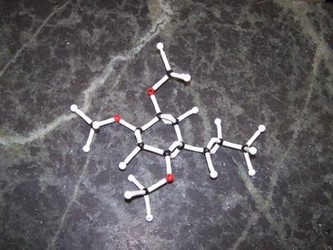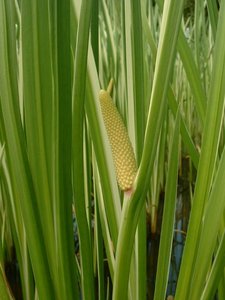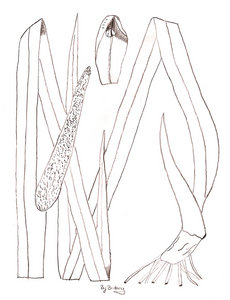Lakota name: Hohwá (This word refers to the leaves; the leaves and stalks are eaten.) Listen to Lakota Plant Name: Hohwá
Listen to Lakota Plant Name: Hohwá
Scientific name: Acorus calamus
Common name: sweet flag or calamus
Lakota medicinal use: pulverized, mixed with gunpowder, and used as a medicine for cramps of arms and legs.
Medicinal uses by other cultures: Calamus root was used as a home remedy for colic. The rhizomes of Acorus calamus contain aromatic oils that have been used medicinally since ancient times and have been harvested commercially. Native Americans exploited Acorus as a medicine and for ceremonial uses. Although this plant is cited in the ethnographic and ethnobotanical literature as Acorus calamus, the distribution of the tribes reported to use Acorus corresponds to the range of the native species.
The root is carminative, slightly tonic, and excitant, and forms a stimulant. It may be used in cases of flatulence, colic, atonic dyspepsia, feebleness of the digestive organs, and to aid the action of cinchona or quinine in intermittents. It forms an excellent substitute, in syrup, for Godfrey's cordial. Externally, it is a valuable application to the skin, and to keep up the discharges from blistered surfaces and issues.
Active compounds produced by this plant: Acorus calamus produces beta-asarone which is a genotoxic (capable of causing genetic mutation and contributing to tumors) phenylpropanoid (produced by plants for defense against herbivores and protection against ultra-violet rays). In an experiment beta-asarone was shown to be active in inducing liver tumours.


Molecular structure of beta-asarone © 1sagebrush1
Description: Acorus calamus is a grass like perennial, pale to dark brown and spongy on the inside, up to 80 cm long, linear to narrowly ensiform or sword shaped, glossy bright green. Acorus calamus is sterile, due to the fact that it has a triploid number of chromosomes (having a chromosome number that is 3 times the basic or haploid number).
Similar species: Acorus gramineus, Acorus americanus
Flowering time: May to August
Habitat: streams banks and marshes






 Go to quick links
Go to quick search
Go to navigation for this section of the ToL site
Go to detailed links for the ToL site
Go to quick links
Go to quick search
Go to navigation for this section of the ToL site
Go to detailed links for the ToL site